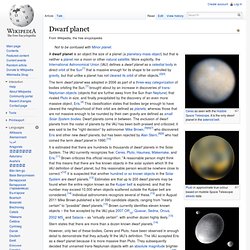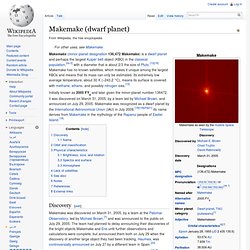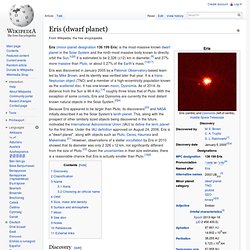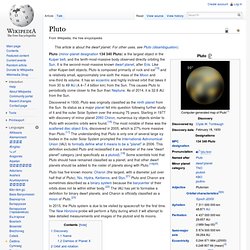

Dwarf planet. Pluto in approximate true colour based on Hubble Space Telescope albedo data A dwarf planet is an object the size of a planet (a planetary-mass object) but that is neither a planet nor a moon or other natural satellite.

More explicitly, the International Astronomical Union (IAU) defines a dwarf planet as a celestial body in direct orbit of the Sun[1] that is massive enough for its shape to be controlled by gravity, but that unlike a planet has not cleared its orbit of other objects.[2][3] However, only two of these bodies, Ceres and Pluto, have been observed in enough detail to demonstrate that they actually fit the IAU's definition. Makemake (dwarf planet) Makemake (minor-planet designation 136,472 Makemake) is a dwarf planet and perhaps the largest Kuiper belt object (KBO) in the classical population,[nb 2] with a diameter that is about 2/3 the size of Pluto.[10][18] Makemake has no known satellites, which makes it unique among the largest KBOs and means that its mass can only be estimated.

Its extremely low average temperature, about 30 K (−243.2 °C), means its surface is covered with methane, ethane, and possibly nitrogen ices.[15] Despite its relative brightness (it is about a fifth as bright as Pluto),[nb 3] Makemake was not discovered until well after many much fainter Kuiper belt objects. Haumea (dwarf planet) Two teams claim credit for the discovery of Haumea.

Mike Brown and his team at Caltech discovered Haumea in December 2004 on images they had taken on May 6, 2004. On July 20, 2005, they published an online abstract of a report intended to announce the discovery at a conference in September 2005.[23] At around this time, José Luis Ortiz Moreno and his team at the Instituto de Astrofísica de Andalucía at Sierra Nevada Observatory in Spain found Haumea on images taken on March 7–10, 2003.[24] Ortiz emailed the Minor Planet Center with their discovery on the night of July 27, 2005.[24] Brown initially conceded discovery credit to Ortiz,[25] but came to suspect the Spanish team of fraud upon learning that his observation logs were accessed from the Spanish observatory the day before the discovery announcement. Ceres (dwarf planet) From Earth, the apparent magnitude of Ceres ranges from 6.7 to 9.3, and hence even at its brightest it is too dim to be seen with the naked eye except under extremely dark skies.
Piazzi's book "Della scoperta del nuovo pianeta Cerere Ferdinandea" outlining the discovery of Ceres, dedicated the new "planet" to Ferdinand I of the Two Sicilies One of the astronomers selected for the search was Giuseppe Piazzi at the Academy of Palermo, Sicily. Before receiving his invitation to join the group, Piazzi discovered Ceres on 1 January 1801.[19] He was searching for "the 87th [star] of the Catalogue of the Zodiacal stars of Mr la Caille", but found that "it was preceded by another".[17] Instead of a star, Piazzi had found a moving star-like object, which he first thought was a comet.[20] Piazzi observed Ceres a total of 24 times, the final time on 11 February 1801, when illness interrupted his observations.
The name Ceres is pronounced /ˈsɪəriːz/ (SEER-eez).[24] Eris (dwarf planet) Eris (minor-planet designation 136199 Eris) is the most-massive known dwarf planet in the Solar System and the ninth-most-massive body known to directly orbit the Sun.

[d] It is estimated to be 2,326 (±12) km in diameter,[9] and 27% more massive than Pluto, or about 0.27% of the Earth's mass.[10][17] Routine observations were taken by the team on October 21, 2003, using the 1.2 m Samuel Oschin Schmidt telescope at Mount Palomar Observatory, California, but the image of Eris was not discovered at that point due to its very slow motion across the sky: The team's automatic image-searching software excluded all objects moving at less than 1.5 arcseconds per hour to reduce the number of false positives returned.
When Sedna was discovered, it was moving at 1.75 arcsec/h, and in light of that the team reanalyzed their old data with a lower limit on the angular motion, sorting through the previously excluded images by eye. Distribution of trans-Neptunian objects. Pluto. In 2015, the Pluto system is due to be visited by spacecraft for the first time.

The New Horizons probe will perform a flyby during which it will attempt to take detailed measurements and images of the plutoid and its moons. Discovery Discovery photographs of Pluto In the 1840s, using Newtonian mechanics, Urbain Le Verrier predicted the position of the then-undiscovered planet Neptune after analysing perturbations in the orbit of Uranus. Subsequent observations of Neptune in the late 19th century caused astronomers to speculate that Uranus' orbit was being disturbed by another planet besides Neptune.
In 1906, Percival Lowell, a wealthy Bostonian who had founded the Lowell Observatory in Flagstaff, Arizona in 1894, started an extensive project in search of a possible ninth planet, which he termed "Planet X".[25] By 1909, Lowell and William H. Name.